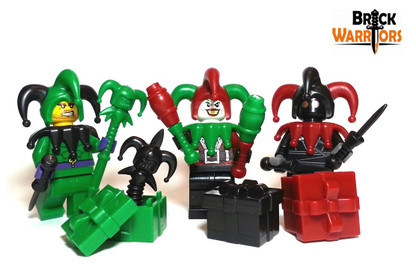Brickwarriors in History – Jesters and Silly Fools
Posted by Guest Blogger: R. A. Denny on 5th Nov 2014
Power tends to go to leader’s heads, especially when they surround themselves with sycophants who tell them only what they want to hear. Your minifigs may have to deal with an Egyptian Pharaoh, a Chinese Emperor, a medieval European King, or some other powerful person in history who needs to lighten up! To perform this trick you will need a fool.
Almost every culture in history had a role for fools. From the clowns of the Hopis, to the mimes of the Romans, they played a valuable role. As early as the Middle Kingdom in Egypt, scenes on Egyptian tombs feature entertainers juggling.
Two kinds of fools exist, artificial and natural. Common belief was that only children and fools told the truth. Dressed in their ridiculous clothes, fools could get away with all kinds of bizarre behavior. They could say and do all sorts of things that maybe we’d all like to do, except that if we did people might think we were crazy.
Many cultures have holidays where people can do things they are not otherwise allowed to do: the Romans had Saturnalia, where the masters served their slaves; in medieval times they appointed a Lord of Misrule beginning on All Hallows Eve (Yep, that’s Halloween!) who presided over a mock court during holiday revelry. Yet, lucky jesters got to turn things upside down all year long!
In war time, jesters have played important roles on and off the battlefield. The famous Chu warrior, Xiong Yiliao, in a Chinese battle in about 603 BC, stepped out between the armies and juggled nine balls and the attackers were so amazed they all went home. On the other hand, in 1066 William the Conqueror’s jester, Taileffer rode beside him to entertain the troops. When the battle was about to begin, he asked permission to ride out between the lines, where he juggled his sword while singing the Song of Roland, but his talents did not send the English back to their houses.Instead an Englishman rushed him, was killed, and the battle began.
Over the years, jesters around the world juggled balls, knives, shields, machetes, apples and even clubs.Juggling clubs are based on Persian meels that were used as training for wrestling.
Some jesters were multitalented storytellers, comedians, poets, singers, musicians, actors, tumblers, jugglers, and magic performers. While many fools wandered from village to village performing at fairs and markets, some fortunate few were chosen to perform for royalty. Those could become quite rich. While many a jester became a favorite of a monarch, they had to be careful, because if they went too far and angered the ruler, they could be beheaded! Still, if they were witty enough they could talk their heads back on, like the Chinese jester who suggested to the emperor “If your majesty takes my head, it will be absolutely useless to you, and extremely painful to myself.” The emperor laughed and changed his mind.It was up to the fool to expose his folly.
To top it all off, in medieval times, jesters were believed to have healing powers! Although medicine has changed a lot since then, many modern doctors would agree that laughter can be a powerful medicine.
In the end, the trickster, the clown, the fool, or the jester is an agent of change. So, whatever era of history your minifigs inhabit, change their world, by filling it with laughter. Make a custom Lego minifigure jester! Take any minifig with a shaved head, give him a hat that looks like it has donkey ears and a tail with bells on the ends (BW Jester Hat) and add a motley collar with bells (BW JesterCollar). Next, your King of Foolishness will need a comical scepter with a carved head upon it, called a bauble or a marotte (BW Jester Staff) to misrule. He or she (there were female jesters too), will need some juggling clubs (BW JugglingPin) to entertain the noble court. They’ll laugh so hard they cry when your jester surprises them by pulling his clubs apart to reveal knives!
Like the German clockmaker in the 1500s who presented his prince’s son with a “devil in the box,” from which a comical devil with an evil smile popped out, your jester can delight his prince with a BW Death in the Box (as long as the prince doesn’t get too close or “Pop” goes the prince’s head!)
So, arm your Lego minifigure with laughter, the weapon of the powerless. In his play, Thomas Nashe puts these words in the mouth of the character based on the famous Will Somers (Jester to King Henry VIII of England): “I have a toy in my head.” Well said.Shouldn’t we all?
Are you silly or not?
If you said “No,” that’s the wrong answer.
Written by guest blogger R. A. Denny. View her blog HERE



